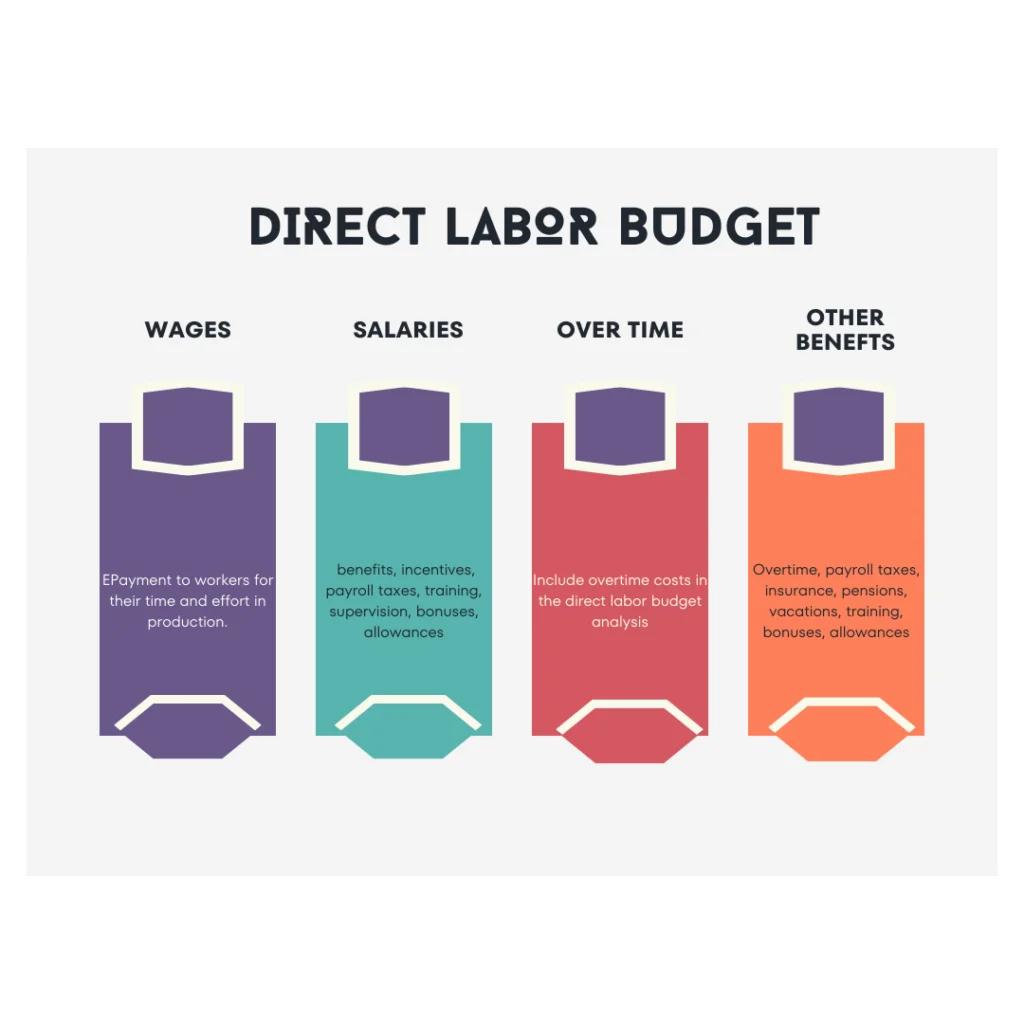Definition of Direct Labor Budget
A Direct Labor Budget is a financial plan that estimates the costs associated with the workforce directly involved in producing goods or providing services. It focuses on the expenses related to the employees who directly contribute to the production process. This budget helps businesses project and manage the costs of wages, salaries, and related expenses for their production team.
In simpler terms, the Direct Labor Budget is a tool that assists companies in forecasting how much money they need to allocate for the workers directly involved in making the products or delivering the services. By outlining these costs, organizations can better plan and control their financial resources, ensuring a smoother and more efficient production process.
Components of Direct Labor Budget
The components of a Direct Labor Budget are essential elements that contribute to the comprehensive planning and management of a company’s workforce-related expenses. Direct labor, which involves the employees directly engaged in producing goods or delivering services, forms the primary component. These individuals play a pivotal role in the core operations of the business. On the other hand, the Indirect Labor component encompasses employees whose efforts support the production process indirectly, such as administrative staff, supervisors, or maintenance personnel.

By delineating these components, the Direct Labor Budget provides a detailed breakdown of anticipated labor costs, facilitating effective resource allocation and financial planning. This budgeting approach enables businesses to align their workforce strategy with overall financial objectives, ensuring a balanced and efficient utilization of human resources. In essence, understanding the components of the Direct Labor Budget is integral to fostering operational excellence and fiscal responsibility within an organization.
Direct Labor Defined
Direct labor refers to the workforce directly engaged in the hands-on production of goods or delivery of services within a business. These individuals contribute directly to the creation of the final product or service, and their labor is measurable in terms of time spent on production. Direct labor costs encompass wages, benefits, and other associated expenses tied directly to the employees involved in the production process.
Understanding direct labor is crucial for businesses to effectively manage and budget their labor resources, ensuring efficiency and cost-effectiveness in the production of goods or services.
Indirect Labor Explained
Indirect labor refers to the workforce engaged in activities that support but do not directly contribute to the production of goods or services. These employees, while essential, are not directly involved in the core operational tasks. Examples include administrative staff, supervisors, and maintenance personnel.
Indirect labor costs are crucial for businesses to consider when budgeting and planning, as they contribute to the overall operational expenses. Effectively managing indirect labor ensures smooth business operations, employee support, and facility maintenance, thereby enhancing overall organizational efficiency and effectiveness. It is a part of manufacturing overhead.
Direct Labor Budget Formula
Its Formula is a fundamental tool in financial planning, computed by multiplying the anticipated production units by the standard hours required for each unit and the labor cost per hour. Mathematically expressed as:
Direct Labor Budget= Anticipated Production Units×(Standard Hours per Unit×Labor Cost per HourDirect Labor Budget)
Application of the Direct Labor Budget Formula
The application of the Direct Labor Budget Formula is a strategic approach for businesses to forecast and manage labor costs efficiently. By multiplying the expected production units by the standard hours required per unit and the labor cost per hour, organizations gain a precise estimate of their labor expenses. This empowers companies to allocate resources effectively, preventing overruns or shortages in workforce planning.
For instance, if a company plans to produce 1,000 units, each requiring 2 standard hours at a labor cost of $15 per hour, the direct labor budget would be 1,000 \times 2 \times 15 = $30,000. This figure serves as a guideline for financial planning, ensuring businesses align their labor force with production needs, and fostering financial prudence and operational efficiency.
Real-world Example for Direct Labor Budget
In a manufacturing scenario, let’s consider a company that produces widgets. The Direct Labor Budget becomes a vital tool for anticipating and managing labor costs. Suppose the company plans to produce 5,000 widgets, with each unit requiring 3 standard hours of labor, and the labor cost per hour is $20.
Here’s how the Direct Labor Budget is calculated:
| Production Units | Standard Hours per Unit | Labor Cost per Hour | Direct Labor Budget |
|---|---|---|---|
| 5,000 | 3 | $20 | 5,000 \times 3 \times 20 = $300,000 |
In this example, the Direct Labor Budget helps the company foresee that producing 5,000 widgets will incur a labor cost of $300,000. This insight aids in financial planning, ensuring that the workforce is aligned with production needs. It’s a practical illustration of how the Direct Labor Budget Formula translates into real-world budgeting, promoting effective resource allocation and cost control.
Recapitulation of Key Concepts
In essence, It is a financial roadmap that estimates costs associated with the workforce directly engaged in production. It meticulously outlines wages, salaries, and related expenses for those integral to the manufacturing or service delivery process.
The components of this budget distinguish between Direct and Indirect Labor. Direct Labor involves hands-on production, while Indirect Labor supports operations indirectly. Recognizing these components facilitates a detailed breakdown of anticipated labor costs, ensuring efficient resource allocation and financial planning.
The Direct Labor Budget Formula, a cornerstone in financial planning, multiplies production units by standard hours and labor cost per hour. Its application empowers businesses to project and manage labor expenses accurately, preventing workforce-related challenges and fostering operational efficiency.



